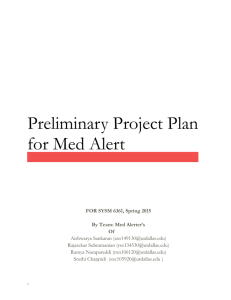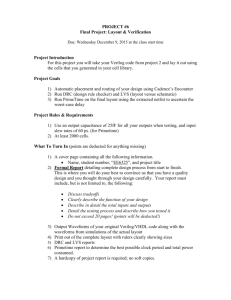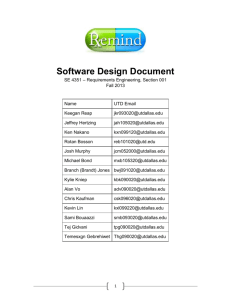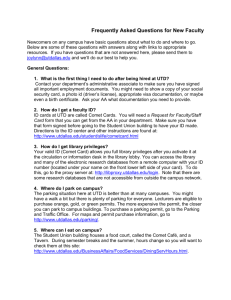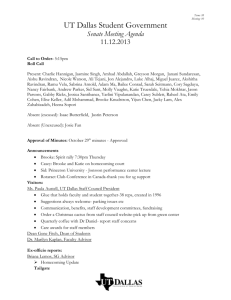RE_Projectplan - The University of Texas at Dallas
advertisement
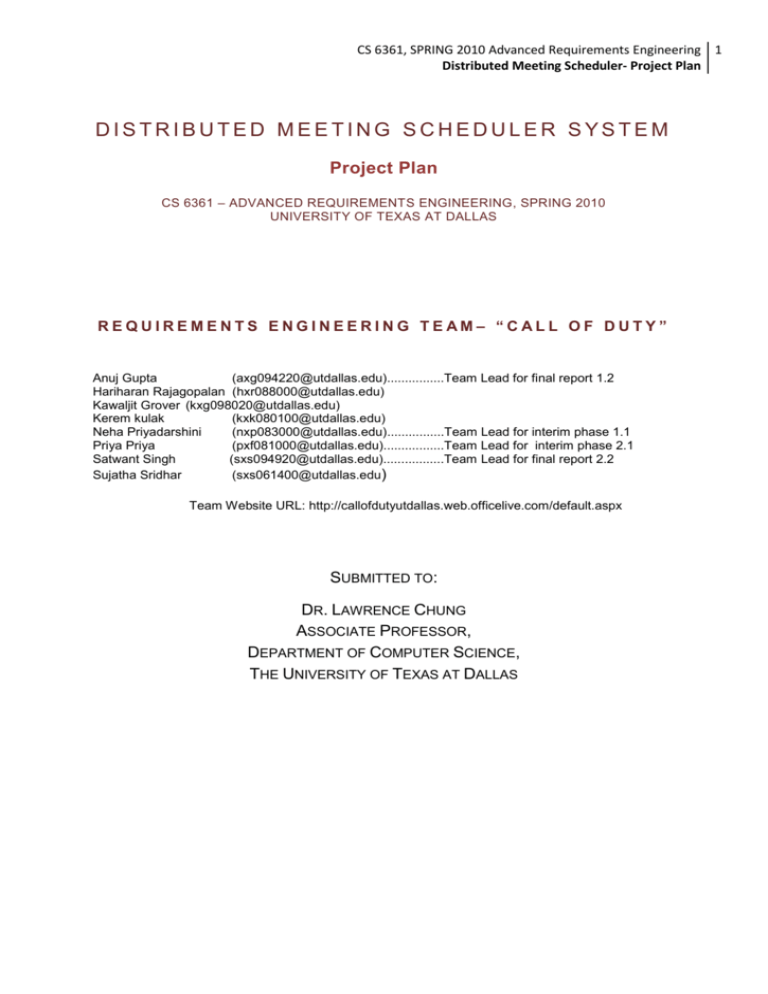
CS 6361, SPRING 2010 Advanced Requirements Engineering 1 Distributed Meeting Scheduler- Project Plan DISTRIBUTED MEETING SCHEDULER SYSTEM Project Plan CS 6361 – ADVANCED REQUIREMENTS ENGINEERING, SPRING 2010 UNIVERSITY OF TEXAS AT DALLAS REQUIREMENTS ENGINEERING TEAM– “CALL OF DUTY” Anuj Gupta (axg094220@utdallas.edu)................Team Lead for final report 1.2 Hariharan Rajagopalan (hxr088000@utdallas.edu) Kawaljit Grover (kxg098020@utdallas.edu) Kerem kulak (kxk080100@utdallas.edu) Neha Priyadarshini (nxp083000@utdallas.edu)................Team Lead for interim phase 1.1 Priya Priya (pxf081000@utdallas.edu).................Team Lead for interim phase 2.1 Satwant Singh (sxs094920@utdallas.edu).................Team Lead for final report 2.2 Sujatha Sridhar (sxs061400@utdallas.edu) Team Website URL: http://callofdutyutdallas.web.officelive.com/default.aspx SUBMITTED TO: DR. LAWRENCE CHUNG ASSOCIATE PROFESSOR, DEPARTMENT OF COMPUTER SCIENCE, THE UNIVERSITY OF TEXAS AT DALLAS CS 6361, SPRING 2010 Advanced Requirements Engineering 2 Distributed Meeting Scheduler- Project Plan “The hardest single part of building a software system is deciding precisely what to build. No other part of the conceptual work is as difficult as establishing the detail technical requirements, including the entire interface to people, to machines, and to other software systems. No part of the work so cripples the resulting system if done wrong. No other part is more difficult to rectify later.” [Brooks, 1987] Revision History Author Date Description Version Team 01/25/2010 Initial version of the project plan document 1.0 CS 6361, SPRING 2010 Advanced Requirements Engineering 3 Distributed Meeting Scheduler- Project Plan Table of Contents 1 Introduction ................................................................................................................................................... 4 1.1 Project Overview ................................................................................................................................... 4 1.2 Stakeholders.......................................................................................................................................... 4 1.3 Project Scope ........................................................................................................................................ 4 1.4 Project Usability .................................................................................................................................... 5 1.5 Project Deliverables .............................................................................................................................. 5 1.6 Evolution of this Document................................................................................................................... 5 1.7 References............................................................................................................................................. 6 1.8 Definitions, Acronyms and Abbreviations ............................................................................................. 6 2 Project Organization ...................................................................................................................................... 7 2.1 Process Model............................................................................................................................................ 7 2.2 Organizational Structure ........................................................................................................................... 7 2.3 Organizational Boundaries and Interfaces .............................................................................................. 10 2.4 Project Responsibilities ............................................................................................................................ 10 2.5 Team Meetings ........................................................................................................................................ 10 3 Managerial Process ...................................................................................................................................... 11 3.1 Management Objectives and Priorities ................................................................................................... 11 3.2 Assumptions, Dependencies, and Constraints ......................................................................................... 11 3.3 Risk Management .................................................................................................................................... 11 3.4 Monitoring and Controlling Mechanisms ................................................................................................ 12 4 4.1 Technical Process ......................................................................................................................................... 12 Methods, Tools and Techniques .............................................................................................................. 12 4.1.1 Method ................................................................................................................................................ 12 4.1.2 Tools: ................................................................................................................................................... 12 4.1.3 Techniques .......................................................................................................................................... 12 5 Glossary........................................................................................................................................................ 13 CS 6361, SPRING 2010 Advanced Requirements Engineering 4 Distributed Meeting Scheduler- Project Plan 1 Introduction This document provides background information for the rest of the document. It briefly describes the project, the client deliverables, the project milestones, and expected document changes. 1.1 Project Overview Distributed Meeting Scheduler is aimed at developing an application to schedule, monitor, plan and re-plan meetings. The purpose of DMS is to support the organization of meetings and to determine for each meeting request, a meeting date and location so that most of the intended participants will effectively participate. The principal users of this system are the Meeting Initiator and Meeting Attendees/Participants. It is the responsibility of the meeting initiator to schedule the meeting based on the availability of the attendees along with the constraints expressed by the attendees/participants. The meeting scheduler system shall have the ability to handler several meeting requests in parallel and resolve conflicts. The key functionalities of this system are: Schedule/ plan meetings Monitor meetings, especially held in a distributed environment Re-planning of meetings to support changing user constraints Support conflict resolution Keep participants informed of the meeting schedules and any changes 1.2 Stakeholders The main stakeholders of any software application would be Pupils, Employees, the Government, the Local community. In our case we are considering the following stakeholders: Clients Project Manager Team Lead Subject Matter expert Module Lead Team Members 1.3 Project Scope The scope of the system will include Scheduling the meeting in efficient way. Gathering the feedback from attendee. Cancelling the meeting. Changing the meeting schedule and/or location. CS 6361, SPRING 2010 Advanced Requirements Engineering 5 Distributed Meeting Scheduler- Project Plan Scheduling concurrent meetings in timely manner. Conducting virtual meetings. Confirming the location and time of the meeting. Trying to save efforts of user of the system. 1.4 Project Usability Automate the meeting schedule process to enable efficient use of the time and efforts of meeting organizer. Select a date and time according to the availability of the participants. Allocate the location that is convenient to all the participants. Send reminders to the participants about the meeting and any schedule changes. Reorganize and modify the meeting schedule if required. Arrange virtual meetings (audio and video conferencing) in case there are remote attendees. 1.5 Project Deliverables The project is divided into two phases with each phase having two sub-phases. The below table provides on the deliverables in each phase and their corresponding deadlines: DELIVERABLE Phase 1 COMPLETION DATE Preliminary Project Plan 1.0 2010.01.28 Interim Report 1.1 2010.03.02 Final Presentation and Report 1.2 2010.03.25 Interim Report 2.1 2010.04.15 Final Presentation and Report 2.2 2010.04.27 Phase 2 1.6 Evolution of this Document This document will be updated as the project progresses. A new revision will be released after each modification. Every modification has to be logged in the Revision History. Updates should be expected in the following sections: a. References – will be updated as necessary. b. Definitions, acronyms, and abbreviations – will be updated as necessary. c. Organizational Structure – will be updated as the roles and responsibilities are assigned for each phase. d. Management objectives and priorities – will be updated to as priorities change. CS 6361, SPRING 2010 Advanced Requirements Engineering 6 Distributed Meeting Scheduler- Project Plan e. Assumptions, dependencies and constraints – will be updated as necessary. f. Risk management – will be updated as new risks are identified. g. Technical Process – will be updated as requirements become clearer. h. Work elements, schedule and budget – will be updated in the case of schedule or budget changes. 1.7 References [1] Requirement Engineering – Advanced Requirement Engineering. CS/SE 6361 Section 001, Spring 2010. http://www.utdallas.edu/~chung/RE/syllabus.htm [2] Project Description: Requirements Elicitation: Initial Understanding http://www.utdallas.edu/~chung/RE/Project1.pdf [3] http://www.utdallas.edu/~chung/CS6354/CS6354_U07_source/Team_2/SoftwareProject Management_Plan_v1.1_Team2.doc [4] http://re-project.org/Documents/Final_Project_Plan.doc [5] http://www.utdallas.edu/~chung/RE/Presentations09F/PioneerTeam/RE%20Deliverable/ [6] Roles and responsibilities www.csuchico.edu/cms/Readiness/roles.doc [7] www.search.org/files/doc/sample%20project%20plan.doc - section 3.2, 3.4 1.8 Definitions, Acronyms and Abbreviations Following are the important terms and their definitions related to schedule meeting: Meeting organizer - One who is responsible for managing meetings. Example –ensure meeting should start and end at scheduled time, review agenda, prepare minutes of meeting. Meeting Initiator - One who make necessary arrangements for the meeting. Example - decide location. Exclusion Set – Dates or times ranges when participants cannot attend meeting. Preference Set – Give the dates preference for meeting. Date Conflict – When date and time of the two meetings conflict. CS 6361, SPRING 2010 Advanced Requirements Engineering 7 Distributed Meeting Scheduler- Project Plan Date Range –Give the range of dates when meetings take place. Duration -The time duration of meeting. Active Participants – One or more participants who give presentations in the meeting. They are the one who called for to attend meeting. Regular Participants – Participants who attend meeting, listen and ask questions from the active participant. Location – Physical location of the meeting room. Required equipment - Equipments such as microphone, projector, blackboard, and stationary needed to conduct the meeting. Virtual meeting – When participant located at different location, then meeting happens not in a room but via telephone, videoconference etc. 2 Project Organization 2.1 Process Model The process used for this project will be an agile methodology, based on empirical rather than defined methods. Agile methods involve planning what one wants and then adapting these plans to the results. It is an Iterative approach where requirements and solutions evolve through collaboration between self-organizing cross-functional teams. We will use UML tools to create the system model and the subsequent breakdown of the design. 2.2 Organizational Structure CS 6361, SPRING 2010 Advanced Requirements Engineering 8 Distributed Meeting Scheduler- Project Plan Project Management Team The Project Management Team is comprised of the Project Leads, Project Manager and chaired by the Project Manager. The charge of the committee is to share information among teams and address implementation issues that impact multiple applications. Meet on a scheduled basis to discuss and resolve implementation issues Project Manager The Project Support Manager assists with project planning, budget analysis, coordination of communication activities and training programs. Involved in other support activities as the situation dictates. Serves as member of the Project Management Team. Assist implementation staff with project planning tools Analyze budget needs and monitor expenditures Coordinate project site set up Act as liaison between project team and client Team Lead The Team Lead is responsible for managing the team activities and schedule. Serves as a member of the Project Management Team. Works closely with project sponsor to gather user requirements. Project planning System development and testing Documentation development Status reporting Technical coordination with local technical staff and Subject Matter Expert Responsible for understanding the application domain and compile enterprise requirements Determine the scope of the problem, identify stakeholders, and analyze the existing system to compile Enterprise Requirements Module Team Lead The Module Team Lead ensures that the work of the team proceeds as planned. Works closely with the Team lead. Monitors team tasks and progress CS 6361, SPRING 2010 Advanced Requirements Engineering 9 Distributed Meeting Scheduler- Project Plan Maintain activity log Provide status report to Team lead Develop and maintain task plans Convene team meetings Assist with Issue technical resolution Responsible for mentoring of new members of the team Review of deliverables from Team Members Module Team Members The Module Team Members work under the direction of the Module Team Lead. Assist in resolution of administrative and/or academic issues Define business practices Participate in data mapping/conversion activities and system testing Attend team module meetings Project Manager Team Lead Module Lead Module Lead Team Member Subject Matter Experts Team Member Team Member Team Member CS 6361, SPRING 2010 Advanced Requirements Engineering 1 Distributed Meeting Scheduler- Project Plan 0 Role Team Member Client Kerem Kulak Project Manager Neha Team Lead Priya Priya Subject Matter Expert Anuj Module lead Sujatha Team Members Hari, Satwant, Kawal 2.3 Organizational Boundaries and Interfaces Team leaders in each phase will be responsible for coordinating team meetings, updates, communications, and team deliverables. Team leader will also be responsible in working closely with the stakeholders of the project to understand the system domain and functionality. 2.4 Project Responsibilities The entire project team is responsible for the successful delivery of the product. Team member assignments per deliverable according to expertise 1. Project Plan – Entire Team 2. Interim report 1.1 – Entire Team 3. Final report 1.2 – Entire Team 4. Interim report 2.1 – Entire Team 5. Final Report 2.2 – Entire Team 2.5 Team Meetings Below table provides the participation of the team members for the team meeting: MEETIN G NO. DATE ANUJ HARI KAWAL KEREM NEHA PRIYA SATWANT SUJATHA 1 24-JAN-10 X X X X X X X X 1 1 1 1 1 1 1 1 TOTAL CS 6361, SPRING 2010 Advanced Requirements Engineering 1 Distributed Meeting Scheduler- Project Plan 1 3 Managerial Process 3.1 Management Objectives and Priorities The objective of the project is to develop a meeting Scheduler system within allocated time, budget and specified quality. The project is highly prioritized due to high benefits to the organization. One of the important usages of this project is that it will automate the process of meeting scheduling and thus save the time and efforts of meeting organizer. More benefits will be further discussed ahead. The primary focus of our team is the reliability, usability, and quality. Satisfying requirements and perfecting the product is very important to us. Meeting user's needs is our top goal. 3.2 Assumptions, Dependencies, and Constraints The following will be the major assumptions in this project: 1. Management will ensure that project team members are available as needed to complete project tasks and objectives 2. All project participants will abide by the guidelines identified within this plan 3. Project Plan might change based on new information revealed or issues encountered. 4. Availability of customer for meetings and trainings The project has identified two major constraints: 1. Cost 2. Time 3.3 Risk Management The initial Risk Assessment attempts to recognize, characterize, prioritize and document a mitigation approach relative to those risks which can be identified prior to the start of the project. This section outlines the risks identified at the start of the project 1. Continuous stream of requirements changes 2. Business owners may not be available during validation phase; this may affect the schedule. 3. Timeline Estimates Unrealistic or Schedule Slips 4. Level of experience in team 5. Absence of Commitment Level 6. Project Team Availability 7. Physical Location of Team prevents effective management CS 6361, SPRING 2010 Advanced Requirements Engineering 1 Distributed Meeting Scheduler- Project Plan 2 3.4 Monitoring and Controlling Mechanisms The following are the monitoring and controlling mechanisms for the risks identified in the project. 1. Continuous review of project momentum by all levels 2. Regularly track and report project progress 3. Redistribute tasks in case of delay in completion prioritizing as per requirement 4. Pre-plan tasks in case the task's complexity had been under estimated before 5. Have clearly identified and usable deliverable 6. Communication of any changes to the requirement being document and communicated to the team. 7. Use of Intranet project website, comprehensive Communications Plan 4 Technical Process 4.1 Methods, Tools and Techniques 4.1.1 Method The Method we will be following will have a flavour of agile Methodology, an incremental and iterative approach. 4.1.2 Tools: The tools and applications used by the team for this project: a) Document Development: Microsoft Office Word b) Architectural and Design Diagrams: IBM Rational Rose c) Communication : Google Groups d) Development: JSP, Java, J2EE, HTML 4.1.3 Techniques The Techniques we will be using in our project will be majorly focused on Model driven development, Test driven development, and object oriented development. MDD gives architects the ability to define and communicate a solution while creating artifacts that become part of the overall solution. MDD is also comprised of the ability to visualize the domain, such as a business domain, and the generation of implementation artefacts. The Model-Driven Architecture (MDA) defines an approach to modelling that separates the specification of system functionality from the specification of its implementation on a specific technology platform. In short it defines a guideline for structuring specifications expressed as models. Test Driven Design (TDD). With a TDD approach you create a test then write enough production code to fulfil that test. In other words, the tests form your detailed design model (as executable specifications), arguably making TDD a modelling approach. CS 6361, SPRING 2010 Advanced Requirements Engineering 1 Distributed Meeting Scheduler- Project Plan 3 Object Oriented Development (OOD) promises to reduce development time, reduce the time and resources required to maintain existing applications, increase code reuse, and provide a competitive advantage to organizations that use it. 5 Glossary Exclusion set - Set of dates on which they cannot attend the meeting Preference set - Set of dates on which they would prefer the meeting to take place
